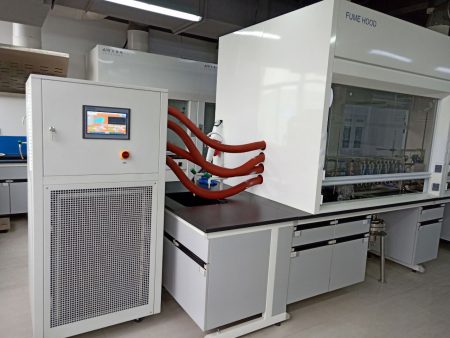Temperature Control System for Semiconductor Processing Machine
Semiconductor temperature control refers to the technology that achieves temperature control through the thermal properties of semiconductor materials. Semiconductor is a substance with electrical conductivity between conductor and insulator. It has thermal properties, such as thermal conductivity, thermal expansion coefficient, heat capacity and carrier mobility. Temperature control technology uses these properties to achieve precise control of temperature and is widely used in electronic equipment, new energy, construction and other fields.
1. Thermal conductivity: Thermal conductivity refers to the ability of a substance to transfer heat. For temperature control technology, the higher the thermal conductivity, the better the heat dissipation performance of the equipment.
2. Thermal expansion coefficient: The thermal expansion coefficient refers to the rate of change of the volume of a substance when its temperature changes. In temperature control applications, the thermal expansion coefficient of semiconductor materials should match the ambient temperature to reduce thermal stress on the device due to temperature fluctuations.
3. Carrier mobility: Carriers refer to particles such as electrons and holes that participate in conduction. The higher the carrier mobility of a semiconductor material, the faster electrons and holes are transported inside the material, which helps to improve the power conversion efficiency of the device.

Semiconductor temperature control technology is mainly divided into the following categories:
1. Passive temperature control: Temperature control is achieved through the thermal properties of the material itself. Common passive temperature control technologies include heat pipes, thermal conductive sheets and phase change materials.
2. Active temperature control: Temperature control is achieved by driving semiconductor devices through external energy (such as electric energy). Active temperature control technologies include thermoelectric refrigeration, thermoelectric power generation and semiconductor lasers.
3. Hybrid temperature control: combines the advantages of passive temperature control and active temperature control to achieve efficient and stable temperature control. Hybrid temperature control technologies include heat pumps, thermoelectric couplers, and thermoelectric refrigeration-solar thermal power generation systems.
Semiconductor temperature control technology has broad application prospects in future development. With the vigorous development of the new energy industry, the application of technology in photovoltaic power generation, electric vehicles, energy storage systems and other fields will become increasingly popular. At the same time, the technology can also be applied to areas such as building energy conservation and industrial production process control, providing strong support for the realization of green and efficient production and lifestyle.
Ofrecemos diseño y fabricación de sistemas completos de control de temperatura. Desde modelos estándar hasta productos personalizados completos de hasta 900 toneladas. Nos especializamos en el servicio al cliente y nos dedicamos a ayudar a cada cliente a tener el sistema de control de temperatura óptimo para su necesidad específica.
Ofrecemos soluciones personalizadas no estándar. Disponemos tanto de enfriadoras individuales como de unidades combinadas de refrigeración y calefacción.
Correo electrónico: lilia@lneya.com WeChat ID: +8615251628237 WhatsApp: +86 17851209193

 LNEYA
LNEYA
 简体中文
简体中文


















































































